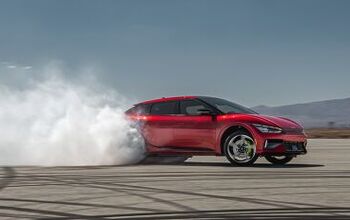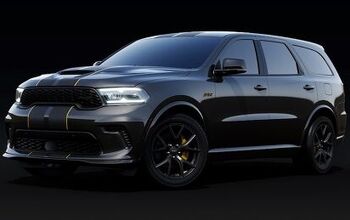Consumer Reports Says EVs Less Reliable Than Traditional Automobiles

Consumer Reports has concluded its annual car reliability survey and the resulting data for 2023 has not been kind to all-electric vehicles. For 2023, CR reported that EVs had 79 percent more problems than automobiles that use internal combustion. Plug-in hybrids were even worse with 146 percent more issues. However, standard hybrids actually outperformed every other group with 26 percent fewer problems than vehicles wholly reliant on gasoline.
“Most electric cars today are being manufactured by either legacy automakers that are new to EV technology, or by companies like Rivian that are new to making cars,” Jake Fisher, senior director of auto testing at Consumer Reports, said in a release. “It’s not surprising that they’re having growing pains and need some time to work out the bugs.”
The biggest issues for EVs were reportedly failing electric drive motors, unreliable charging, and trouble with battery packs. Plug-in hybrids shared similar troubles, with Fisher stating that their usage of two entirely separate powertrains adds complexity that can undermine reliability. It makes sense from an engineering perspective. But it also left your author wondering why standard hybrids weren’t seeing the same number of problems.
Fellow TTAC author Chris Tonn noted that differing maintenance routines could have played a factor, using brakes as an example. Since hybrids use regenerative braking, they tend to outlast disc and drums by a wide margin. Automakers have also been building them a lot longer than their plug-in counterparts and they tend to be based on models that have been around for a while.
“It might not seem that long ago, but Toyota launched the Prius hybrid about 25 years ago,” Steven Elek, head of CR’s data analytics program, stated. “Automakers have been making hybrids long enough that they’ve gotten really good at it. Plus, many hybrids are also made by manufacturers that tend to produce reliable vehicles overall, such as Toyota, Hyundai, and Kia.”
While pure electrics didn’t perform so well, CR did state that the Tesla Model 3 and Model Y were the most mechanically sound EVs in its survey. However, the brand’s experience in building all-electric powertrains doesn’t seem to have helped it in every respect.
“While Tesla’s EV components are generally reliable, the company continues to struggle with the build quality of its vehicles,” said Elek. “Tesla powertrains are now pretty solid for the most part, but Tesla owners report a lot of build quality issues including irregular paint, broken trim, door handles that don’t work, and trunks that don’t close. All of these pull down the brand’s reliability score.”
Mechanical issues are weighted the most heavily in the Consumer Reports reliability survey. If a defect robs a vehicle of motive power and/or results in a giant repair bill, it’s deemed as more important than the windows failing to work or the paint being cheap. But those smaller items can still add up to bring down a vehicle or brand’s overall score. In the case of America’s preeminent EV company, Tesla landed mid pack — sandwiched between Infiniti and Ram.
Lexus and Toyota took the number one and two spots, respectively, and were followed by Mini, Acura, Honda, Subaru, Mazda, Porsche, BMW, and Kia. Meanwhile, brands ranked near the bottom included Chrysler, Mercedes-Benz, Rivian, Volkswagen, Jeep, Volvo, GMC, and Lincoln. Just about every other brand you’ve heard of fell between those nameplates in terms of CR’s reliability ranking.
But it’s worth keeping in mind that the results rely heavily on qualitative data furnished by survey respondents and only includes brands with a sufficiently large sample size. While select brands do seem to have a knack for building durable vehicles, there can also be massive disparities between individual models. Consumer Reports stated that it received responses on more than 330,000 vehicles using 20 potential problem areas ranging from motor and transmission issues to infotainment snafus and minor defects.
Brand-level scoring is determined by examining the weighted overall problem rate for all models within a brand for each model year. Then, overall reliability scores are calculated by averaging results from 2021 to 2023, and some early 2024 data for each brand, depending on sample size. Data is accrued primarily on model years from between 2000 and 2023. This is worth remembering, as a brand having a particularly good or bad stretch of years in the past would undoubtedly impact its overall performance today.
While body types weren’t as relevant as powertrain options in terms of reliability, traditional passenger vehicles continued to outperform the pack. Sedans, hatchbacks, and wagons yielded the highest overall reliability scores. SUVs, crossovers, and minivans were next. Pickups surprisingly came in last place, though this was attributed to truck manufacturers tending to come from less-reliable manufacturers and companies implementing some of their latest features on them. This also meant that all-electric pickups came in dead last in the survey, with more problems than any other vehicle type.
“Sedans have fallen out of favor with consumers, but as a class they are very reliable,” explained Fisher. “They often have less of the latest technology and features that can cause problems before the bugs are worked out.”
That said, there are exceptions to about every blanket statement made above and Consumer Reports attempted to address this. If you’re interested in digging a little deeper, we’d recommend reading its summary of why EVs performed so poorly or its abstract on the reliability between automotive brands.
[Image: Toyota]
Become a TTAC insider. Get the latest news, features, TTAC takes, and everything else that gets to the truth about cars first by subscribing to our newsletter.

A staunch consumer advocate tracking industry trends and regulation. Before joining TTAC, Matt spent a decade working for marketing and research firms based in NYC. Clients included several of the world’s largest automakers, global tire brands, and aftermarket part suppliers. Dissatisfied with the corporate world and resentful of having to wear suits everyday, he pivoted to writing about cars. Since then, that man has become an ardent supporter of the right-to-repair movement, been interviewed on the auto industry by national radio broadcasts, driven more rental cars than anyone ever should, participated in amateur rallying events, and received the requisite minimum training as sanctioned by the SCCA. Handy with a wrench, Matt grew up surrounded by Detroit auto workers and managed to get a pizza delivery job before he was legally eligible. He later found himself driving box trucks through Manhattan, guaranteeing future sympathy for actual truckers. He continues to conduct research pertaining to the automotive sector as an independent contractor and has since moved back to his native Michigan, closer to where the cars are born. A contrarian, Matt claims to prefer understeer — stating that front and all-wheel drive vehicles cater best to his driving style.
More by Matt Posky
Latest Car Reviews
Read moreLatest Product Reviews
Read moreRecent Comments
- JK Savoy Blue is a thing, but Sestriere White? Sestriere is a ski town near Turin, so I guess it meant to conjure up thoughts of snow. Pretty car. I hope Pininfarina has success. The industry in and around Turin has taken a big hit and is a shadow of its former self.
- Ravenuer My 2023 CRV EX, 6 mo old, 4800 miles: $0.
- TheEndlessEnigma My '16 FiST: Oil changes, tires, valve cover gasket (at 112k miles), coolant flush, brakes.....and that's itMy '19 Grand Caravan: Oil changes, coolant flush
- John Clyne I own a 1997 GMC Suburban that I bought second hand. It was never smoked in but had lost the new car smell when I got it four years after it was sold new. I own a 2005 Chevrolet Avalanche & that still has the new car smell. I like the smell. I could never afford a new car until the Avalanche. It might be my last new car? Why do they build cars with fire retardant materials in them. Smoking rates are falling & if someone continues to smoke in this day & age is a fool especially with all the information out there.
- Theflyersfan Non-performance models, probably the Civic based on the fact the interior feels and looks better in the Honda. Both of them are going to drive like adequate appliances with small engines and CVTs and get decent mileage, so this is based on where my butt will rest and things my hands and fingers will touch.Toyota doesn't have an answer to the Civic Si so the Honda wins by default.CTR vs GR Corolla. One dealer by me is still tacking on $10,000 markups for the CTR and good luck with the GR Corolla and the "allocation" system. There's that one dealer in Missouri that I pasted their ad a while back wanting $125,000 for a mid-level GR. Nope. But cars.com is still showing markups. Both of these cars will have little depreciation for a while, so the markups equal instant loss. It looks like Cincinnati-area dealers are done with CTR markups. So this is a tough choice. I don't like the Corolla interior. It looks and feels inexpensive. I'm glad Honda toned down the exterior but the excessive wing still looks immature for such an expensive car that 20-somethings likely cannot afford. FWD vs AWD. With price being an object, and long-term maintenance a thing, I'd go with the Honda with a side eye at the Golf R as a mature choice. All with stick shifts.


































Comments
Join the conversation
A lot of TTAC's dumb and dullest give us the old hot take 'see, nobody wants EV's and proof it's a dead end to appease an overreaching government' , but we need to look at the market - a lot of EV's, particularly those by legacy automakers, were rushed through after fear of Tesla's success, as were many Hybrids 15 years ago when the Prius was becoming popular. It's an effort to appease Wall Street and sweep stuff under the rug of their customers in hopes they'll fix it later.
Back in the Cash-for-clunkers era, a family member had the option of getting a Prius but decided on buying a Chevy Malibu because the dealer was wheeeeeelin and deeaallllllin and because 'Toyota's got a reputation but it's just a fact a simpler ICE car will always be more reliable.' Well fast forward to several timing chain failures later and GM crap components and that Malibu's in a junkyard, and I'm sure the Prius that could've been is serving its owner well even with a dead battery. I know someone laughing at Tesla Model 3 drunk russian build quality while their pile-of-crap Ram from 2019 has left them stranded 5 times and will be in the junkyard after its 5th owner gives up and lets the sled lot repo it.
This isn't just Detroit issue either the auto industry's attitude of rushed development is a far bigger issue. And it's not just 'compliance vehicles' - a relative has an outgoing-gen '18 Impreza that's had 5 recalls, broken trim (including window switches- how the hell do you screw that up), cracked intakes, an exhaust leak that leaked CO2 into the cabin, rattling heat shields, a stuck steering rack, and just now bad wheel bearings at 47k miles- freaking wheel bearings. Stuff that'd be a be a soapbox scandal on a car with more political baggage, but you can't make a hot take out of a lowly Impreza.
There is more to it than just poor QA/QC, there are problems with excessive oil consumption due to poor design of the pistons and piston rings. It’s still a problem with their new smartstream engines.